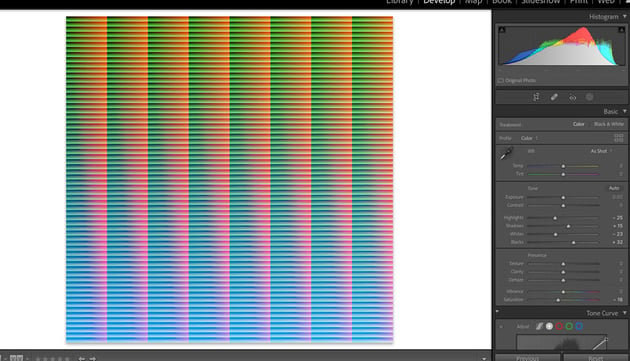So many of us have Lightroom presets that we use often on our photos, specific adjustments that can be repeatedly applied to our still photos at the click of a button. However, what if we wanted to apply these same adjustments to video files? Or maybe you’d like to edit your photos with the same look in another program.
For this, we’ll need to create a Look-Up Table, otherwise known as a LUT.
What is a LUT?
In short, a Look-Up Table (LUT) is a file containing math instructions to replace a one set of colours with another set of colours. The process of creating a LUT is done pixel by pixel, and therefore is incredibly precise.
How to Turn a Lightroom Preset into a LUT
In this tutorial, I’m going to show you how to take your favourite Lightroom preset and turn it into a LUT. This means you’ll be able to apply the same look and feel from your still photos onto your videos with ease!
1. Download a HALD and Import to Lightroom
A HALD is a pattern containing all colour values (pixels) for a specific size of grid. By applying our Lightroom Preset to a HALD, we’ll be able to generate a three-dimensional representation of our two-dimensional image adjustments.
Download a HALD here. Import the JPG or PNG file into Lightroom.



2. Apply Your Lightroom Preset
Apply your favourite preset to the HALD. All of the HALD’s pixels will shift accordingly. It is important to note here that a LUT can only affect things such as colours, contrast, and brightness. Dynamic effects, such as grain, sharpening or vignetting cannot be transferred. If you include these types of effects in can result in a corrupted LUT.



3. Export the HALD, Convert to CUBE
Now that the preset has been applied, let’s export your edited HALD. You’ll need to export as either a PNG (without compression) or a JPG (at 100% quality).
Convert to CUBE
The final step is to convert your edited HALD into a CUBE. I promise this is the last file extension you’ll need to know for this tutorial!
A CUBE is a file that can describe look up tables (LUTs) in a three-dimensional space. This CUBE file will serve as the preset file to apply to your videos. Convert your HALD to CUBE using the free lutcreator.js: Simply click the ‘Convert to .CUBE‘ button, upload your PNG or JPG, and your CUBE file will be created.
4. Apply Your LUT
Open your favourite video editing software and apply the CUBE to your video clips. When applied, your videos will now have the same adjustments that your Lightroom preset contained!
That’s it! You’ve made it! I hope you now see how easy it can be to take the adjustments you’ve refined in Lightroom and apply them to your video work.
More Lightroom Learning
Try these tutorials to learn more about Adobe Lightroom Classic:








